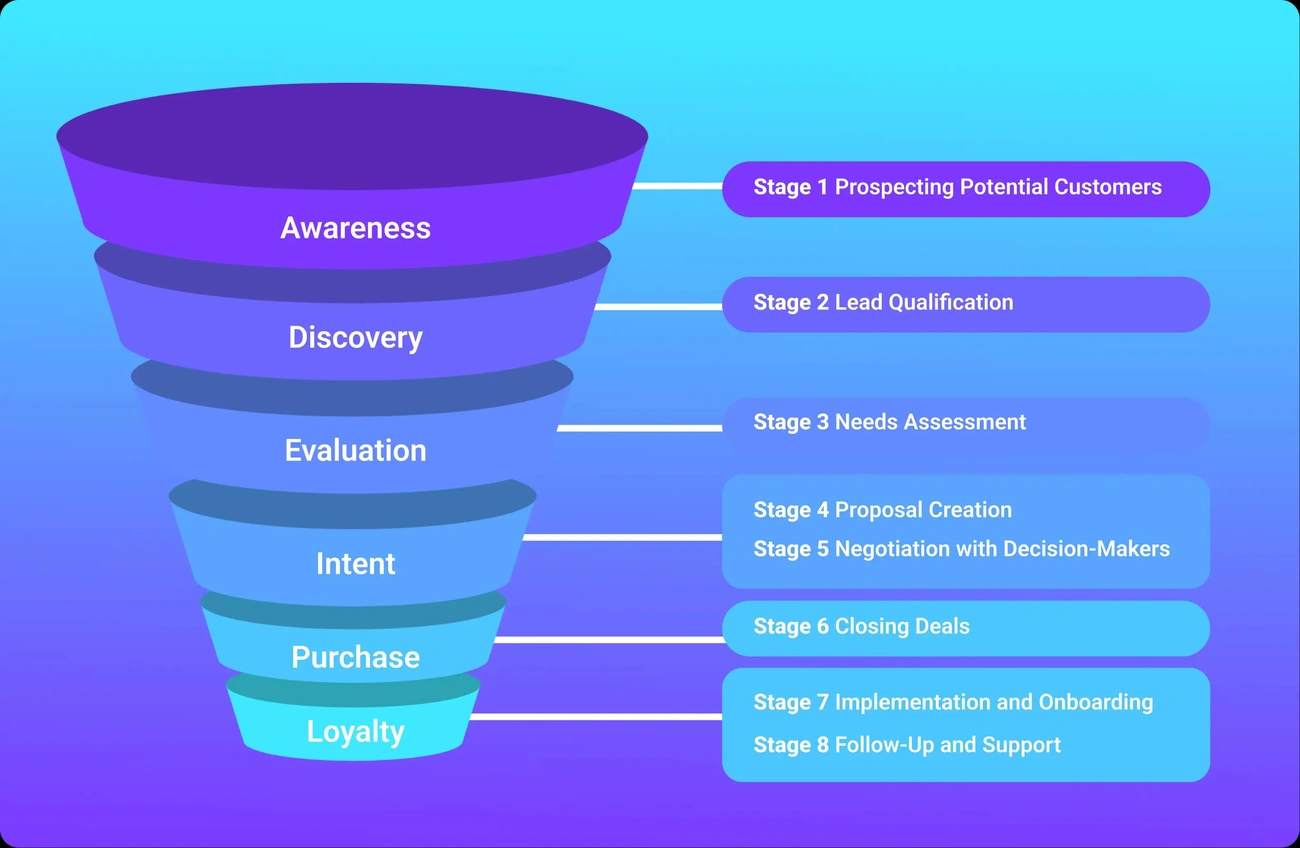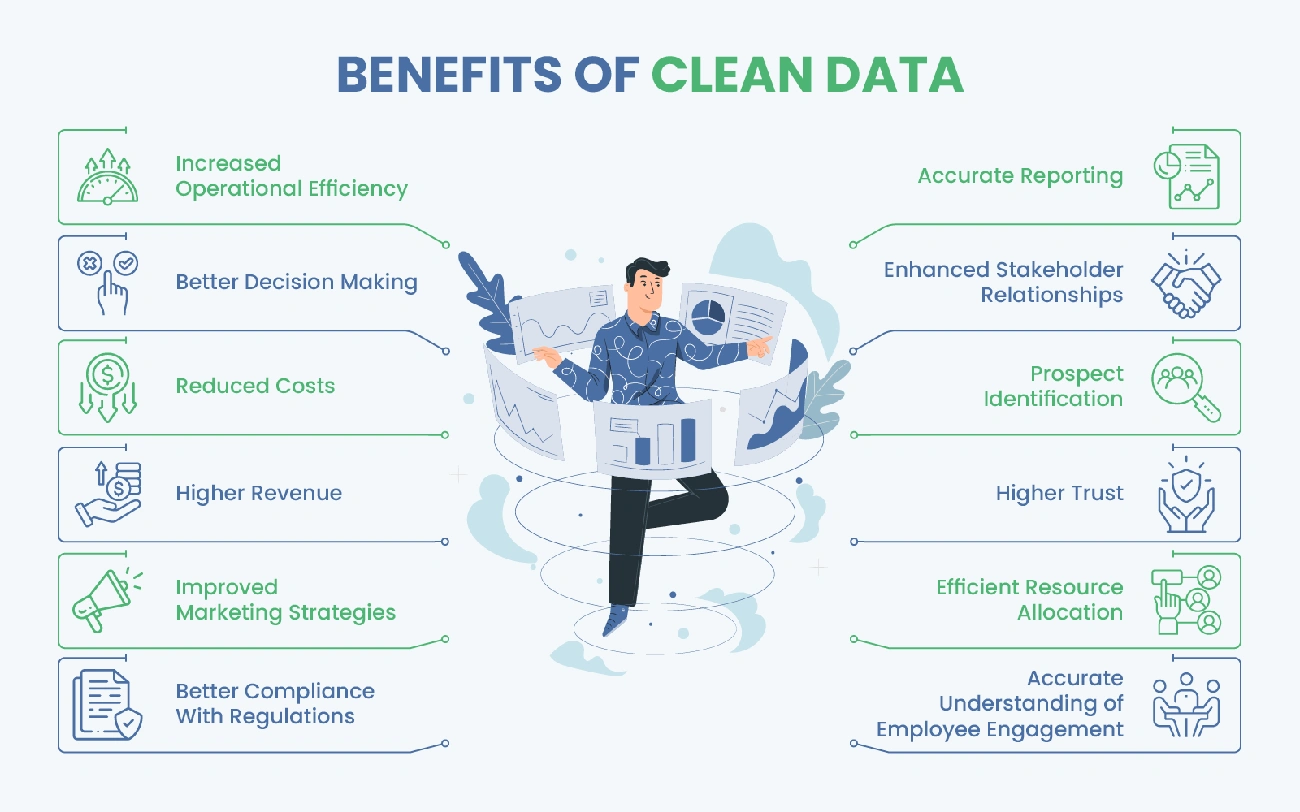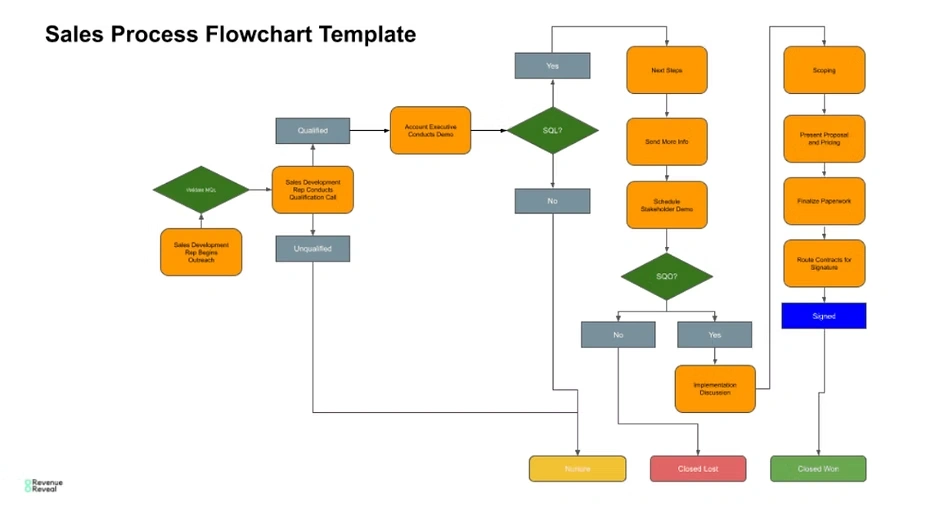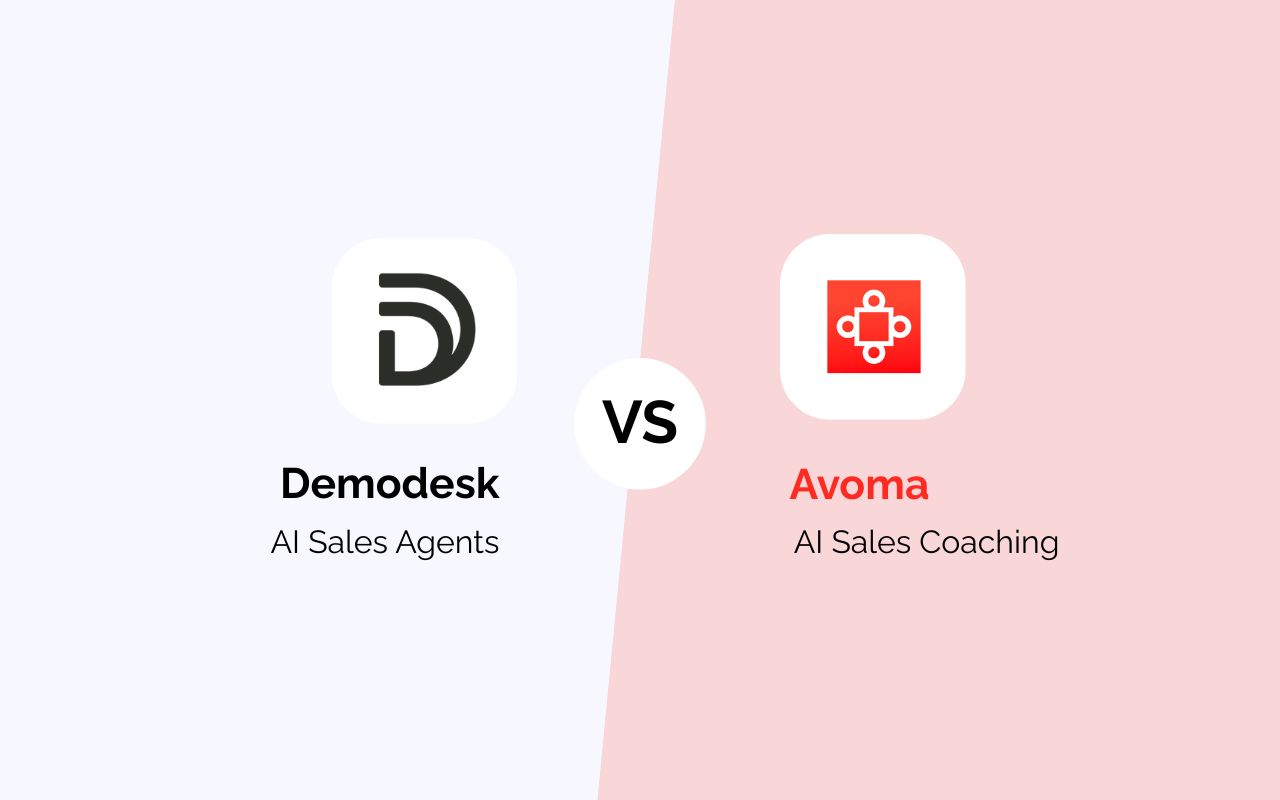Sales process optimization starts with spotting the problems. Sales managers must find the exact breaking points when they notice declining performance metrics. Warning signs show up quietly at first. These small issues can grow into major problems that hurt your bottom line.
10 Signs Your Sales Process Is Broken
After speaking with over 160 sales leaders and teams, we identified the most common signs of a broken sales process and what you can do to fix them. Use this guide to diagnose issues and put better practices in place, whether you’re in sales leadership, operations, or working as a rep.
Lack of Visibility
Sales managers don't deal very well with tracking deal progress because they can't see their team's activities clearly. They can't forecast revenue or spot bottlenecks without a clear view of the sales pipeline. This poor transparency shows up as:
- Team members report inconsistently
- No clear reason why deals get stuck
- Hard to track how customers interact throughout their experience
Sales leaders make decisions with incomplete information when they can't see each stage clearly. This undermines their b2b sales process optimization techniques.
Too Many Tools, Not Enough Integration
Sales teams use many separate platforms, CRM, email, calendar, dialers, and analytics tools. These tools don't work together well. Important data gets stuck in different systems. Sales representatives waste time switching between apps and copying information manually. On top of that, data becomes inconsistent across platforms. This makes it impossible to have one reliable source of customer information.
Weak Onboarding and Training
New sales representatives don't get enough preparation before talking to customers. A poor onboarding process leaves them unprepared to represent your company well. The ongoing training usually offers generic materials instead of personal coaching based on individual performance data. Sales teams can't adapt to market changes or use new strategies well without proper training.
Poor Coaching and Feedback
Sales professionals need regular coaching to perform their best. Many organizations give feedback that's too rare, vague, or focused only on results instead of behaviors. Good coaching needs specific, actionable insights delivered regularly. Representatives develop bad habits that hurt the sales process when managers can't provide analytical feedback or make time for one-on-one sessions.
Manual, Time-Consuming Processes
Sales teams have less time to sell when they spend too much time on administrative tasks. Here's what makes processes too manual:
- Representatives enter the same information in multiple systems
- Hours spent creating custom proposals or quotes
- Following up through spreadsheets or memory
- Creating reports manually instead of automating them
These inefficiencies waste valuable time and show your sales process optimization strategy needs work.
Fragmented Sales Frameworks
Each representative creates their own method without a standard selling approach. Customers get unpredictable experiences and performance becomes hard to measure fairly. New hires must learn different approaches from various team members instead of following one proven process.
Low Tool Adoption
Your sales technology investment becomes useless if your team doesn't use it consistently. Valuable data gets lost when representatives skip official systems or use only some features. Tools that are too complex, poorly integrated with workflows, or seem unhelpful usually have low adoption rates. This resistance to technology makes it hard to track, measure, and improve the sales process.
Poor Lead Management
Bad lead management shows up in several ways. Leads get lost, follow-ups happen at random times, and qualification protocols don't work well. Conversion rates suffer when high-potential prospects get ignored while representatives chase unlikely deals. Good leads slip through the cracks without clear handoff procedures between marketing and sales teams.
These eight warning signs usually appear together. They create a snowball effect that seriously reduces sales effectiveness. Sales managers need to know which problems affect their organization to make real improvements. Early detection of these signs helps address why it happens before revenue or team morale takes a hit.
Additional Signs of a Broken Sales Process
Sales teams face many challenges beyond basic process breakdowns. These can derail even the best-planned sales strategies. Warning signs often build up slowly. They're hard to spot until they start to affect performance badly. Sales leaders need to learn about these warning signs to fix problems completely.
Technical or Integration Problems
System failures often look like human performance issues. Sales teams depend heavily on technology. Software problems can crush productivity quickly. Here are some common examples:
When CRM systems don't sync properly, data conflicts pop up across platforms. This leads to mixed messages about customer interactions. To cite an instance, a sales rep might input details about a prospect's budget limits, but if the system doesn't update right, other team members might follow the wrong approach.
Silent disruptions happen when APIs between sales tools stop working. Reps might think they're doing everything right, but important data never gets where it needs to go. Deals stall without any clear reason.
Random system outages force teams to find quick fixes that stick around forever as unofficial processes. These makeshift solutions usually lack proper tracking and create mess-ups in customer data management. Teams get so used to these workarounds that they don't want to go back to official methods, even after the tech issues are fixed.
Old systems that can't handle modern sales techniques limit your team's potential. Teams might look like they're underperforming when the real problem is outdated tech that can't run today's sales optimization strategies.
Security measures sometimes block legitimate sales activities, especially for remote teams. Reps might not be able to reach important resources or talk to prospects because of strict security rules that weren't made with sales workflows in mind.
Lack of Team Alignment
Even with perfect tech, poor alignment between departments can break your sales process. This shows up in several ways:
Sales and marketing teams send different messages about products, pricing, or target customers. Prospects hear different stories depending on who they talk to. This creates confusion and kills trust. Marketing often brings in leads that sales teams don't think are qualified.
Departments work toward different goals and metrics. Marketing might chase after more leads while sales focuses on better quality ones. Without common goals, each team tries to win at their own game instead of helping the business succeed.
Important information gets stuck in knowledge silos. Customer success teams might learn valuable things about how people use products, but sales reps never hear about it because departments don't share information.
Teams don't know who should do what during handoffs. Important details get lost in these transitions. Customers have to repeat themselves and get a choppy experience. They end up seeing the company as unprofessional.
Sales support materials created without input from front-line reps often miss the mark. These resources don't address real customer concerns or competitive advantages that matter in actual sales situations.
Teams stop working together during busy times when cooperation matters most. Under pressure, everyone protects their own interests instead of focusing on customer experience. This gets really bad during end-of-quarter rushes when teamwork is crucial.
B2B sales process optimization can't work without fixing these breakdown signals. Tech problems and poor team alignment might be harder to spot than other issues, but they can still wreck the best-planned sales strategies.
Here’s your Sales Process Audit Checklist:
How to Fix a Broken Sales Process

Image Source: Artisan
A broken sales process needs systematic changes across your organization. Sales managers must fix specific problems while building a stronger sales approach after identifying issues. Better sales processes come from both technical updates and changes in how teams work.
Most sales teams know their process is broken, but they don’t realize how much time is being lost to routine tasks. Reps spend up to 40% of their time updating CRMs, drafting follow-ups, and manually tracking deals.
That’s exactly where Demodesk comes in. As the first vertical AI sales platform, Demodesk doesn't just analyze what's going wrong — it takes action. From automated CRM updates to drafting personalized follow-ups and detecting deal risks, Demodesk frees your team to focus on selling, not admin.
Centralize Data and Improve Visibility
Your first step is to build a single source of truth. Unite customer information in one central system that updates automatically across platforms. Sales representatives can then access complete interaction histories while managers see accurate pipeline data. Set up standard reporting dashboards showing key metrics like conversion rates between stages, average deal size, and sales cycle length. These dashboards should give both quick overviews and detailed analysis of specific performance issues.
Streamline and Integrate Tools
Check your technology stack to find unused or duplicate tools. Make your remaining systems work together for smooth data flow. Pick platforms with strong API features that connect easily with your core CRM and sales tools. Note that a few well-connected tools work better than many separate apps. Think about using middleware solutions if your critical systems can't connect directly.
Standardize Onboarding and Training
Build structured onboarding programs that blend theory with real-life application. New hires learn best by doing instead of just watching. Map out a clear curriculum with milestones and skill checks at each level. Your ongoing training should target specific skill gaps based on performance data. Add role-playing exercises that mirror real customer objections and competitive situations your team faces.
Modernize Coaching and Feedback
Regular coaching sessions should focus on specific behaviors rather than just results. Call recordings and interaction data help provide fact-based feedback on particular skills. Train your managers to coach effectively by focusing on growth instead of criticism. Build feedback loops where reps can use suggestions right away and get quick guidance. This steady improvement approach works nowhere near as well as quarterly reviews.
Automate Manual Work
Find administrative tasks that eat into selling time and create automation workflows. Focus on repeated tasks like data entry, follow-up scheduling, and proposal creation. Smart automation can give back 3-5 hours of selling time per rep each week. Choose automation projects based on time savings and fewer errors. Start with simple workflows that show quick wins before taking on bigger processes.
Adopt a Consistent Sales Framework
Choose a sales method that matches your buyers' priorities and market position. Your framework, whether it's consultative selling, solution selling, or another approach, should:
- Give clear steps for each sales stage
- Include key questions for customer talks
- Provide templates for common scenarios and objections
- Set clear qualification standards
A consistent approach makes coaching better and performance measurement more accurate.
Drive Tool Adoption
Get your reps involved in picking new tools to meet real needs. Tool adoption becomes natural instead of forced. Give complete training that shows benefits more than features. Share success stories where tools helped win deals or save time. Add game elements that reward regular use and good data. Your leadership team must use these same tools when working with the team.
Optimize Lead Management
Set clear lead qualification standards that both sales and marketing teams agree on. Define response times and follow-up sequences. Good lead management needs proper handoffs between teams that keep context and momentum. Use lead scoring to rank prospects based on their engagement and how well they match your ideal customer profile.
Sales managers can turn broken processes into smooth, working systems by fixing each problem area. This organized approach not only solves current issues but builds a foundation for ongoing improvement as markets change.
More Fixes for Your Sales Process
Sales managers must solve two more crucial problems to fix their sales operations completely after making simple process improvements. These specific solutions target both technical infrastructure and team dynamics that need attention beyond process changes.
Fix Technical Issues Fast
Technical problems grow bigger quickly when nobody fixes them. They can cause failures throughout the sales process. Sales managers should set up a clear plan to handle technical problems:
- Build a technical response team with people from sales and IT departments
- Set up a system to rank problems based on how they affect revenue
- Create quick fixes for important functions while working on permanent solutions
- Run regular system checks to spot problems early
- Keep records of all technical issues and solutions that everyone in sales can access
Finding and fixing problems before they happen works better than solving them later. Regular system checks help spot potential issues or slowdowns. Many companies now use monitoring tools that send alerts to team members when systems don't work well.
Tough technical problems might need outside help. Expert consultants who focus on sales technology often find problems that internal teams miss because they've worked with many different sales teams and systems.
Promote Team Alignment
The best process improvements fail if departments don't work together well. Teams need clear structure and good communication. Sales managers should build understanding and teamwork through several approaches.
Set goals that connect different departments first. Don't let marketing focus only on leads while sales chases close rates. Create shared metrics that track customer progress from start to finish. Teams work better together when they share responsibility for results.
Next, set up clear ways for departments to share information:
- Hold regular meetings between teams about specific customers or products
- Let marketing, sales, and customer success teams see all customer data
- Plan and run campaigns together
- Work as one team to fix conversion problems
Write down every step of the customer's experience. Make it clear what each department does and how they hand off work. But papers alone won't help - people need training and practice too.
Start programs where team members work in other departments briefly. This helps them understand their coworkers' challenges better. People learn how their work affects others.
Leaders must show how to work together by respecting what each department brings to the table. If executives don't value teamwork, departments will care more about their own goals than company success.
These fixes work with the simple process improvements to create a complete sales optimization strategy. Sales managers who fix technical systems and improve teamwork build stronger operations that adapt to market changes smoothly.
Best Practice Process for CRM Hygiene

Image Source: 360MatchPro
Clean CRM data is the backbone of successful sales operations. Sales teams can execute strategies with confidence when their CRM system stays clean and up-to-date. Their decisions rest on accurate information. Good CRM hygiene serves as the foundation that supports all other sales process improvements we discussed earlier.
Sales organizations need systematic procedures that become part of their daily operations to keep CRM data clean. Clear protocols should exist for data entry, regular cleaning, and monitoring to prevent data from getting messy. A solid CRM hygiene process has:
- Data standardization rules that specify exactly how information should be entered
- Regular audit schedules with assigned responsibilities
- Automated validation tools that flag inconsistencies
- Procedures to merge similar records
- Archiving policies for outdated information
- Data enrichment protocols to keep records current
Bad data costs companies are nowhere near just inefficiency. Research shows companies lose 15-25% of their revenue due to poor data quality. Sales reps waste 4-6 hours each week dealing with CRM data problems that proper hygiene would prevent.
Example: What Good CRM Hygiene Looks Like
A mid-size B2B software company shows excellent CRM hygiene through its all-encompassing approach. The company's original "data dictionary" defines every field in their CRM system. They automate CRM entry with Demodesk and defining all fields removes confusion about where information belongs. Every team member uses this dictionary as a reference point to ensure consistency across hundreds of daily interactions.
The sales operations team runs automated data quality reports every Monday through Demodesk AI reports. These reports find incomplete records, duplicates, and formatting issues. Sales team members must fix these flagged problems before their Wednesday pipeline reviews. This ensures no strategy discussions happen with faulty data.
The company's validation rules stop common errors right at entry. To name just one example, phone numbers must follow specific formats. The system checks company names against existing records automatically to prevent duplicates. On top of that, it pulls data from trusted third-party sources to keep firmographic information current without manual work.
The company made CRM maintenance part of their performance metrics, which proved crucial. Sales managers review their representatives' data hygiene scores along with revenue metrics. This accountability makes proper documentation a habit rather than an option.
New hires go through specific CRM usage training modules. They receive certification only after they show proficiency in proper data management. The team takes refresher training every quarter to learn about process improvements and system updates.
The results tell a compelling story. After starting these hygiene practices, their sales forecasting accuracy jumped by 32%. Sales cycle length dropped by 18%. Sales representatives saved around 5 hours weekly - time they previously spent cleaning data and searching for information. Now they use this time for customer interactions.
This company's system changed from a necessary administrative task to a real competitive edge by making CRM hygiene central to their sales process optimization strategy. Their story proves that good data maintenance doesn't just support sales processes - it speeds them up.
Key Elements of a Better SDR to AE Handoff

Image Source: LinkedIn
Sales Development Representatives (SDRs) and Account Executives (AEs) face their biggest challenge during handoffs. This crucial transition point can make or break many promising deals. The handoff process is the life-blood of sales optimization, and it determines whether qualified leads turn into revenue or vanish completely. Smart organizations know they need well-laid-out processes instead of casual arrangements.
A smooth SDR-to-AE handoff eliminates failures through clear protocols and ownership. Teams must define qualification criteria with objective thresholds. Both SDRs and AEs should agree on these indicators of sales-readiness. Teams often clash when AEs reject leads they see as poorly qualified, which wastes valuable prospecting work.
Knowledge transfer must go beyond simple contact details. Teams need to share complete interaction history, documented pain points, and buying signals from original conversations. AEs can then continue discussions naturally without making prospects repeat information.
Good handoffs need a proper transfer meeting. SDRs should verbally share their observations about how prospects communicate, their company dynamics, and competitive landscape. These details might not fit in standard CRM fields but are a great way to get relationship insights.
Response time matters greatly. Prospects should not wait long between qualification and AE follow-up. Top organizations create agreements that specify maximum response times for new opportunities. These usually range from 2-24 hours based on urgency.
Successful transitions need both SDRs and AEs to share responsibility. They must work together to move opportunities through early pipeline stages. This partnership prevents the common problem of teams simply passing leads without care.
Summary of Our Approach
The best SDR-to-AE handoff method uses a three-phase process that balances detail with speed.
1. SDRs start by filling out standard qualification documents that give AEs complete background information.
2. Next comes a transfer conversation—either a quick meeting or recorded video—where SDRs highlight key insights.
3. The process ends with a joint introduction call including both SDR and AE. This creates a smooth experience for prospects and helps transfer relationships naturally.
Organizations using this well-laid-out approach see their conversion rates improve by 20-35% in just one quarter. Sales cycles become shorter because AEs start customer relationships with better understanding of needs and motivations.
Key Takeaways
Fixing a broken sales process isn’t just about tweaking stages or adding tools, it’s about eliminating inefficiencies and building a system that scales.
With Demodesk, sales teams increase productivity by 25%, close 30% more deals, and cut CAC by 20%. By automating post-call workflows, enhancing coaching, and keeping your CRM clean with zero effort, Demodesk empowers every team member to perform at their best, from day one.
Data integrity is the life-blood of any sales process improvement effort. Clean CRM data provides the foundation for all other optimization strategies. Accurate information makes forecasting possible and improves decision-making. Sales organizations with rigorous data hygiene protocols gain substantial advantages through streamlined processes and reduced wasted effort.
Critical transition points like SDR-to-AE handoff yield substantial returns. These moments become vulnerability points where opportunities often stall or vanish. Well-laid-out handoff processes with clear accountability mechanisms boost conversion rates and shorten sales cycles.
Sales managers should see process optimization as an ongoing experience instead of a one-time fix. Market conditions evolve, buyer priorities change, and new technologies emerge. The most successful organizations build cultures of continuous improvement where teams assess processes and make incremental improvements regularly.
It's worth mentioning that process improvements deliver results only with consistent execution.




.png)
%201.avif)

.png)





